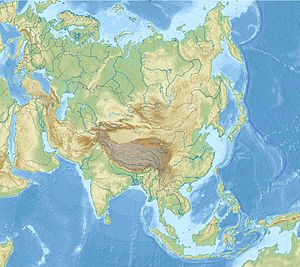Lupar River
| Lupar Sungai Batang Lupar | |
|---|---|
 Sunset at Lupar | |
| Native name | Batang Lupar (Malay) |
| Location | |
| Country | Malaysia |
| Physical characteristics | |
| Source | Klinkang Range |
| • location | Malaysia |
| Mouth | |
• location | South China Sea, Malaysia |
• coordinates | 1°30′51.6″N 110°58′58.7″E / 1.514333°N 110.982972°E |
• elevation | 0 m (0 ft) |
| Length | 275 km (171 mi) |
| Basin size | 6,558 km2 (2,532 sq mi) |
| Discharge | |
| • location | Sebuyau, Kampung Teriso, South China Sea (near mouth) |
| • average | 490 m3/s (17,000 cu ft/s) |
The Lupar River (Malay: Sungai Batang Lupar or Batang Lupar) is a river in Sarawak, Malaysia. The river mouth is located between Sebuyau and Kampung Teriso, in Sri Aman Division.
Overview
[edit]The Lupar River flows from the Klinkang Range towards the South China Sea. The river flows 275 kilometers and is the third longest river in Sarawak, after the Rajang River and Baram River.[1][2]
- Notable settlements
Notable settlements along the Lupar River, arranged from the mouth to upriver are:
Natural attractions
[edit]- Tidal bore
The tidal bore, known locally as benak is a unique natural phenomenon in which the incoming tide form waves as high as three meters that travel up the river against the current. The Lupar River is among 56 places in the world where the tidal bore has been observed.
The Benak Festival (Malay: Pesta Benak) is held annually along the bank of the Lupar River in Sri Aman. Besides water-based events, the festival also features Miss Tourism Benak and Ratu Kebaya Benak, singing competitions and food bazaars, traditional games, a trade expo with sale of local produce, an exhibition on the tidal bore in Batang Lupar and a showcase of traditional Iban, Malay and Chinese wedding ceremonies.[5][6]
Wildlife
[edit]- Crocodile attacks
The Lupar River is infamously known for its crocodile attacks.[2] Between 1900 and 2017, 22.2% of crocodile attacks in Sarawak are recorded in the Lupar Basin, the highest in the state.[1]
These crocodile attacks became the source of local legend and mythology, named Bujang Senang (happy bachelor) which refers to a 19 ft-crocodile that inhabited the Lupar River. The colloquial name of "bujang" means someone who is a champ, a great person, and it is a sign of respect while “Senang” refers to the Senang River, one of the tributaries of the Lupar River where the first known attack by this crocodile had happened.[1][7][8] In popular culture, the name Bujang Senang (the Crocs) was adopted as the nickname of the state’s football team Sarawak FA.[9]
References
[edit]- ^ a b c Mohd Izwan Zulaini bin Abdul Gani. "Historical Perspective, Distribution, Ecology and Population Genetics of Saltwater Crocodile (Crocodylus porosus Schneider, 1801) in Sarawak, Malaysian Borneo" (PDF). Retrieved 12 December 2019.
{{cite journal}}: Cite journal requires|journal=(help) - ^ a b c d Malissa Sahari (10 April 2018). "Rohani, Batang Lupar dan geografinya". Astro Awani (in Malay). Retrieved 12 December 2019.
- ^ "Lingga folk still dependent on Batang Lupar". The Borneo Post. 24 February 2011. Retrieved 13 December 2019.
- ^ Joshua Eric (25 October 2019). "Sri Aman jadi Simanggang semula". Harian Metro (in Malay). Retrieved 13 December 2019.
- ^ a b Jack Wong (19 June 2007). "Thousands watch tidal bore at Batang Lupar". The Star. Retrieved 12 December 2019.
- ^ "Tidal Bore Festival (Pesta Benak) 2019". Sarawak Tourism. Retrieved 12 December 2019.
- ^ Husna (10 July 2019). "Lagenda Bujang Senang, Si Buaya Pembaham Ramai Manusia di Sarawak". Libur (in Malay). Retrieved 12 December 2019.
- ^ Badd (28 November 2017). "HERE'S THE STORY BEHIND BUJANG SENANG, A CROCODILE THAT ONCE TERRORIZED SARAWAK". cilisos.my. Retrieved 12 December 2019.
- ^ GERYL OGILVY (31 January 2018). "Crocs aiming to enter top flight". The Star. Retrieved 12 December 2019.


 French
French Deutsch
Deutsch

